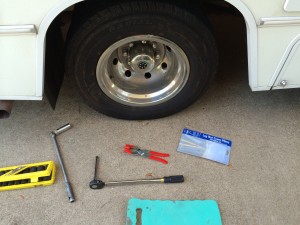Today I learned more about my steel liners than what I really wanted (but needed) to know. For one, I need three different sized sockets to remove a wheel. One size fits the lug nuts that hold the rear liner on, one for the nuts that hold the front liners on, and one size fits the lug nuts that hold the wheels on. Also, I’m glad I bought the special pliers for removing the rear lug caps without crushing them. (The ones with the dimples are the ones that come off, the others are built into the liner and don’t detach) The pliers were actually cheaper in the store at Camping World (with the Good Sam discount) than at the auto parts stores or other online sources.
I also found that the some lug nuts were over-tightened and some were too loose. only a few were baby-bear just right. I know a lot of shops will use some general rule of thumb, but I’m just silly enough to check the owners guide and use the manufacturer’s recommendations. The book says 140 ft-pds. I’m getting old, but I can still generate that with my upper body strength. To loosen some of the nuts I had to stand on my breaker bar. Okay, not with all my considerable weight, but more than what I could press with my upper body. I even cracked a Snap-On socket trying to loosen one. Over-tightened lugs can cause real problems with brake and other wheel components. So if you do take your RV to a shop, make sure you tell them the torque specs for your application.
SPECIAL NOTE: Make sure your socket is fully on each lug and fully seated on you wrench for each lug. I was glad to ‘only’ have a jammed thumb instead of something broken.
Moral: Add “Check Torque” to the annual inspection list. Make sure you have the right tools if you plan to do your own work.

